Crank J. Free and Moving Boundary Problems
Подождите немного. Документ загружается.

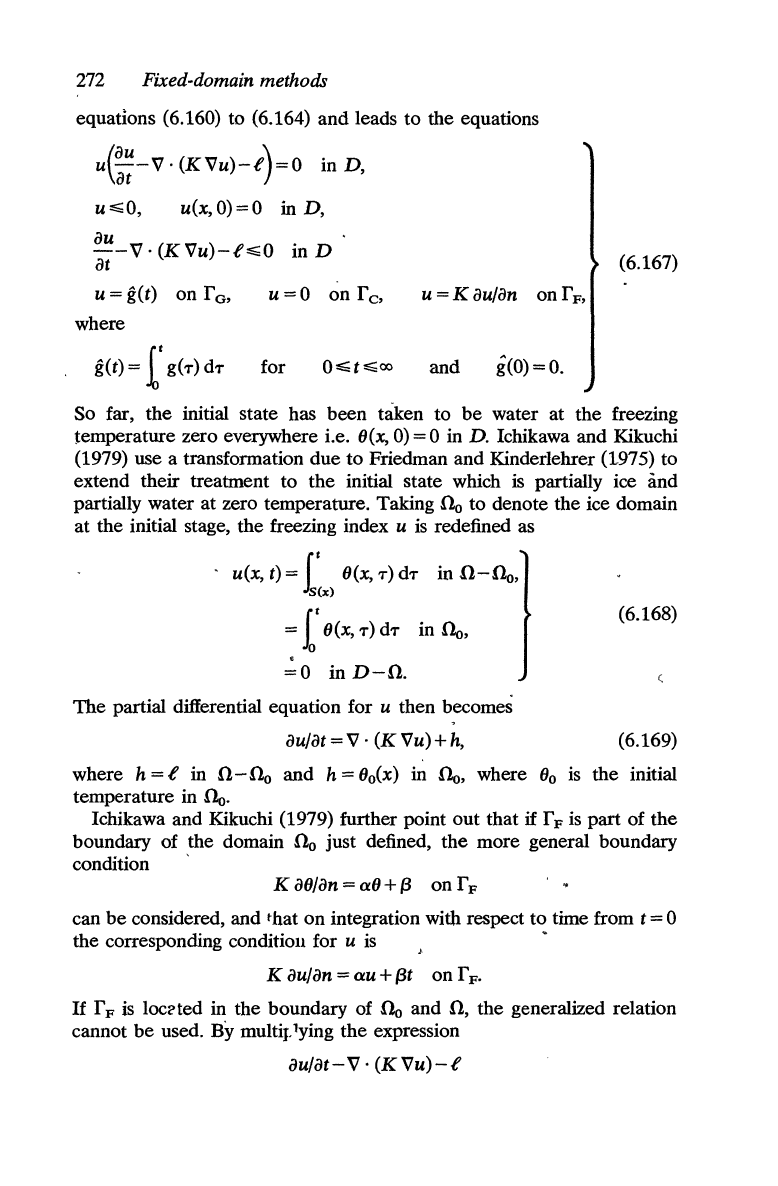
272
Fixed-domain methods
equations (6.160) to (6.164)
and
leads to the equations
ue~
-V,
(KVu)-t)=O
in
D,
U~O,
u(x,O)=O in D,
au '
--V,
(KVu)-t~O
in D
at
u=g(t)
on r
o
,
where
g(t) = f g(T) dT
u=O
on r
c
,
for
u=Kau/an
onr
F
,
and
&(0)=0.
(6.167)
So far,
the
initial state has been
tiken
to
be
water
at
the
freezing
temperature zero everywhere i.e.
6(x, 0) = 0 in D. Ichikawa and Kikuchi
(1979) use a transformation due
to
Friedman and Kinderlehrer (1975) to
extend their treatment to
the
initial state which
is
partially ice imd
partially water
at
zero temperature. Taking 0
0
to denote the ice domain
at
the
initial stage, the freezing index u
is
redefined as
u(x, t) =
it
6(x,
T)
dT
in n-Oo,
sex)
= f 6 (x,
T)
dT in
00,
.
=0
in
D-O.
The
partial differential equation for u then becomes
au/at=v·
(KVu)+h,
(6.168)
(6.169)
where
h = t
in
0-0
0
and h = 6
0
(x)
in
00,
where 6
0
is
the initial
temperature in
00.
Ichikawa and Kikuchi (1979) further point
out
that
if
r F
is
part of
the
boundary of the domain 0
0
just defined,
the
more general boundary
condition '
K a6/an =
0:6+13
on
r
F
can
be
considered, and that on integration with respect to time from t = 0
the corresponding conditioll for
u
is
•
K aujan =
au
+
I3t
on r
F'
If
r F
is
loc?ted in the boundary of
00
and
0,
the
generalized relation
cannot
be
used.
By
multiJ-lying
the
expression
au/at-V'
(KVu)-t
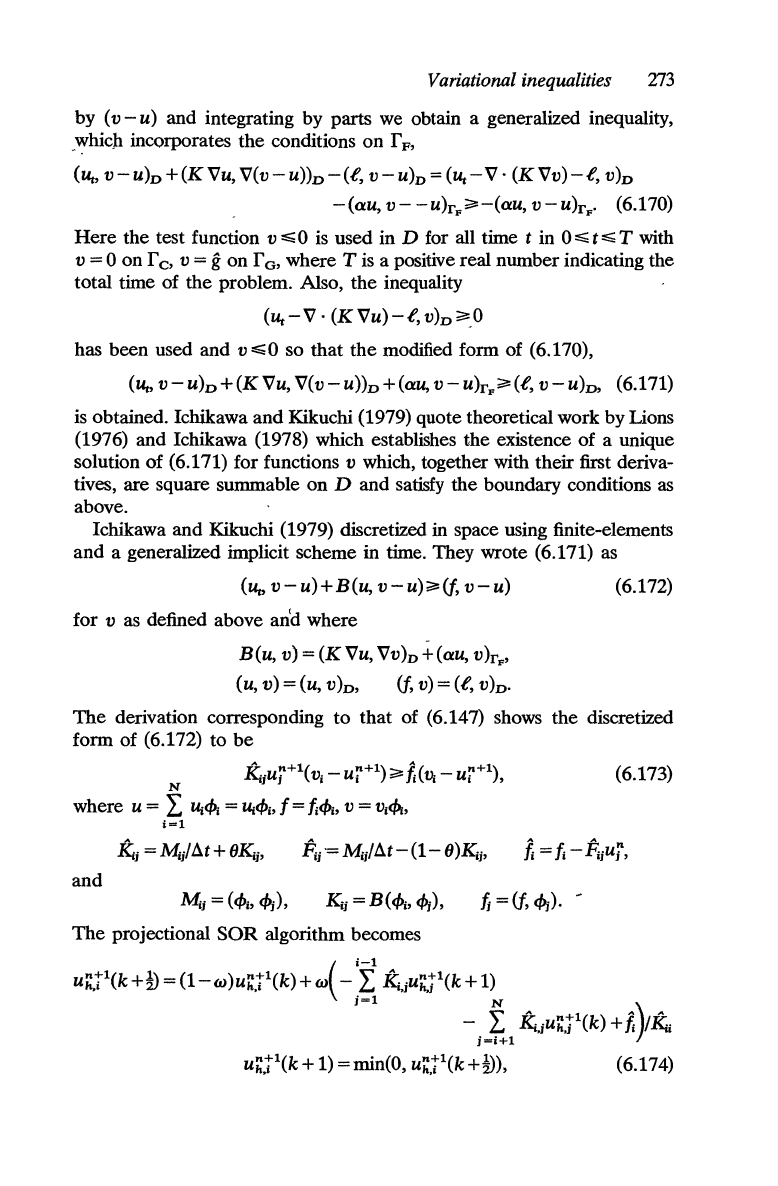
Variational inequalities
273
by (v - u) and integrating by parts we obtain a generalized inequality,
.which incorporates the conditions
on
r
F,
(Ur,
v-u)o
+(KVu,
V(v-
u»o-(t,
v-
u)o =
(Ur-V·
(KVv)-t,
v)o
-(au,
v -
-u)rF;;'-(au,
v -
u)r
F
.
(6.170)
Here
the test function v ~ 0 is used
in
D for all time t in 0 ~ t ~ T with
v = 0
on
r c, v = g
on
r
G,
where T is a positive real munber indicating the
total time of
the
problem. Also, the inequality
(Ur-V·
(KVu)-t,
v)o;;'O
has been used and
v~O
so that
the
modified form of (6.170),
(Ur,
v -
U)D
+(KVu,
V(v -
U)D
+ (au, v - u)rF;;.(t, v - u)o, (6.171)
is obtained. Ichikawa
and
Kikuchi (1979) quote theoretical work by Lions
(1976) and Ichikawa (1978) which establishes the existence of a unique
solution
of
(6.171) for functions v which, together with their first deriva-
tives, are square summable
on
D and satisfy
the
boundary conditions as
above.
Ichikawa and Kikuchi (1979) discretized in space using finite-elements
and
a generalized implicit scheme in time. They wrote (6.171) as
(Ur,
v -
u)+B(u,
v - u);;.(f, v - u)
for v as defined above an'd where
B(u,
v) =
(KVu,
VV)o + (au,
v)r
F
,
(u,v)=(u,v)o,
(f,v)=(t,v)o'
(6.172)
The
derivation corresponding
to
that
of (6.147) shows
the
discretized
form
of
(6.172) to
be
N KijUj+1(Vi -
u?+1)
;;'/;(tlj -
U?+1),
(6.173)
where
u = L
U;<Pi
=
u;'<Pb
f =
t<Pb
V =
WA,
i=l
and
The
projectional
SOR
algorithm becomes
u;:J1(k+!) = (1-w)u;:.T
1
(k)+w(
_if
K;.ju;:.?(k+1)
j=1
~
A
+1
A)
A
-
t...
~.jU;:.j
(k)
+t
/~i
j=i+l
u;:t1(k+ 1) =min(O, u;:t
1
(k+!»,
(6.174)
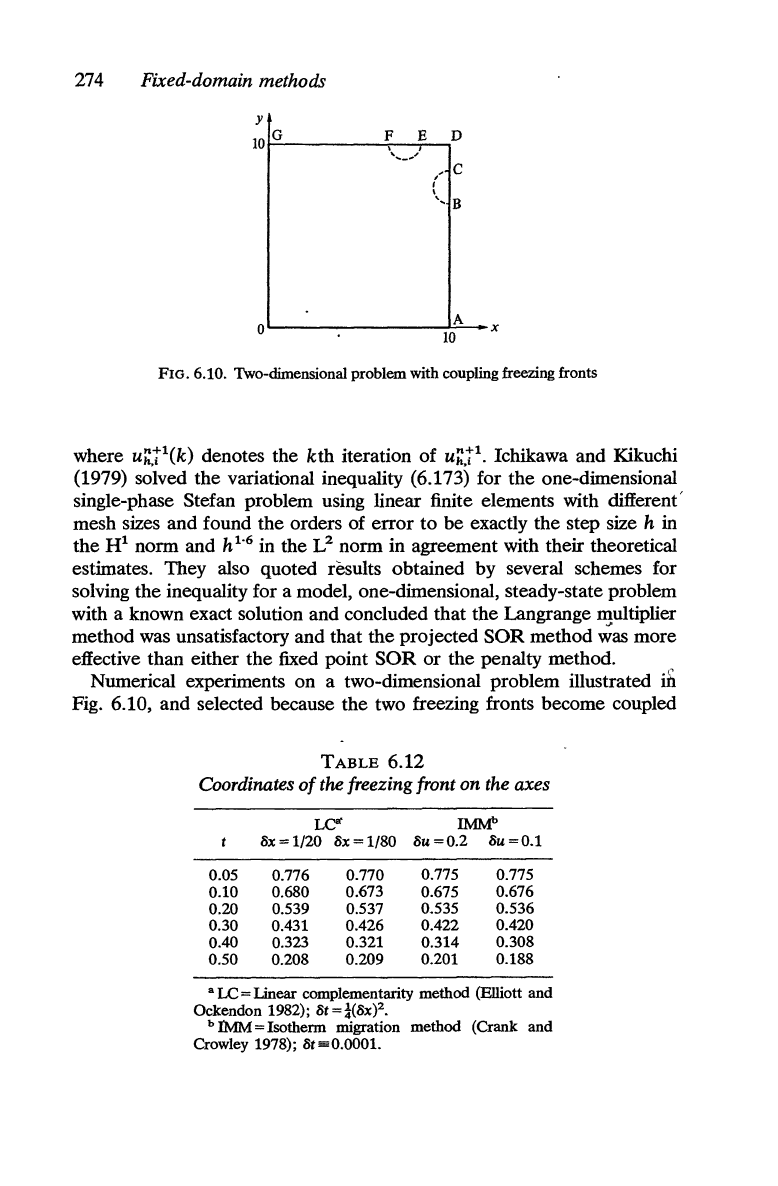
274 Fixed-domain methods
y
10
G
FED
" C
I
\
'-
B
O~----
__________
~A~_x
10
FIG. 6.10. Two-dimensional problem with coupling freezing fronts
where u/:,tl(k) denotes the kth iteration of u/:,t
l
. Ichikawa and Kikuchi
(1979) solved
the
variational inequality (6.173) for
the
one-dimensional
single-phase Stefan problem using linear finite elements with different'
mesh sizes and found the orders of
error
to
be exactly
the
step size h in
the
HI
norm and
h1-6
in the
L2
norm in agreement with their theoretical
estimates. They also quoted results obtained by several schemes for
solving
the
inequality for a model, one-dimensional, steady-state problem
with a known exact solution and concluded that
the
Langrange multiplier
method was unsatisfactory and that
the
projected
SOR
method
~as
more
effective than either
the
fixed point
SOR
or
the penalty method.
Numerical experiments on a two-dimensional problem illustrated iii
Fig. 6.10, and selected because the two freezing fronts become coupled
TABLE
6.12
Coordinates
of
the freezing front on the axes
LCO'
JMMh
8x
==
1/20 8x = 1/80 8u = 0.2 8u = 0.1
0.05
0.776
0.770
0.775 0.775
0.10 0.680
0.673
0.675
0.676
0.20 0.539 0.537
0.535 0.536
0.30 0.431 0.426
0.422 0.420
0.40 0.323 0.321 0.314
0.308
0.50 0.208 0.209
0.201
0.188
a
LC
=
linear
complementarity method (Elliott and
Ockendon 1982);
8t=i(8x)2.
b IMM = Isotherm migration method (Crank and
Crowley 1978);
8t
5
0.OOOl.
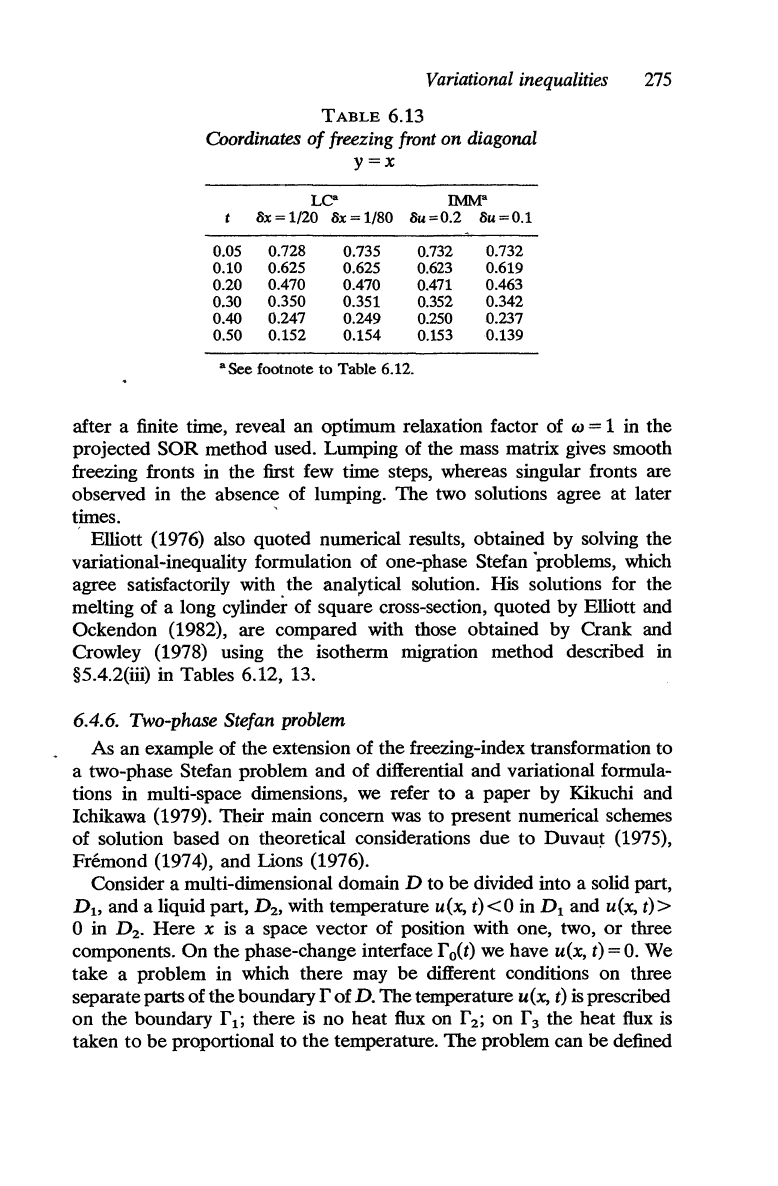
Variational inequalities
275
TABLE
6.13
Coordinates
of
freezing front on diagonal
y=x
Le"
IMM"
8x=1/20 8x=1/80
8u=0.2
8u=0.1
0.05 0.728
0.735 0.732 0.732
0.10 0.625
0.625 0.623 0.619
0.20 0.470
0.470 0.471 0.463
0.30 0.350 0.351
0.352 0.342
0.40 0.247
0.249 0.250 0.237
0.50 0.152
0.154 0.153 0.139
• See footnote
to
Table 6.12.
after a finite time, reveal an optimum relaxation factor of w = 1 in the
projected
SOR
method used. Lumping of the mass matrix gives smooth
freezing fronts in
the
first few time steps, whereas singular fronts are
observed in the absence of lumping.
The
two solutions agree
at
later
times. '
. Elliott (1976) also quoted numerical results, obtained by solving the
variational-inequality formulation of one-phase Stefan problems, which
agree satisfactorily with
the
analytical solution. His solutions for the
melting of a long cylinder of square cross-section, quoted by Elliott and
Ockendon (1982), are compared with those obtained by Crank and
Crowley (1978) using
the
isotherm migration method described in
§5.4.2(iii) in Tables 6.12, 13.
6.4.6. Two-phase Stefan problem
As an example of the extension of
the
freezing-index transformation to
a two-phase Stefan problem and
of
differential and variational formula-
tions in multi-space dimensions, we refer
to
a paper by Kikuchi and
Ichikawa (1979). Their main concern was to present numerical schemes
of solution based
on
theoretical considerations due
to
Duvaut (1975),
Fremond (1974), and Lions (1976).
Consider a multi-dimensional domain
D to be divided into a solid part,
Db
and a liquid part, D
2
,
with temperature u(x,
t)<O
in D1 and u(x,
t»
o in D
2
•
Here
x
is
a space vector of position with one, two,
or
three
components.
On
the phase-change interface f o(t) we have u(x, t) =
O.
We
take
a problem in which there may
be
different conditions on three
separate parts of
the
boundary f of D. The temperature u(x, t)
is
prescribed
on
the boundary f
1
; there
is
no heat
flux
on f
2
; on
f3
the heat
flux
is
taken
to
be
proportional
to
the
temperature.
The
problem can
be
defined
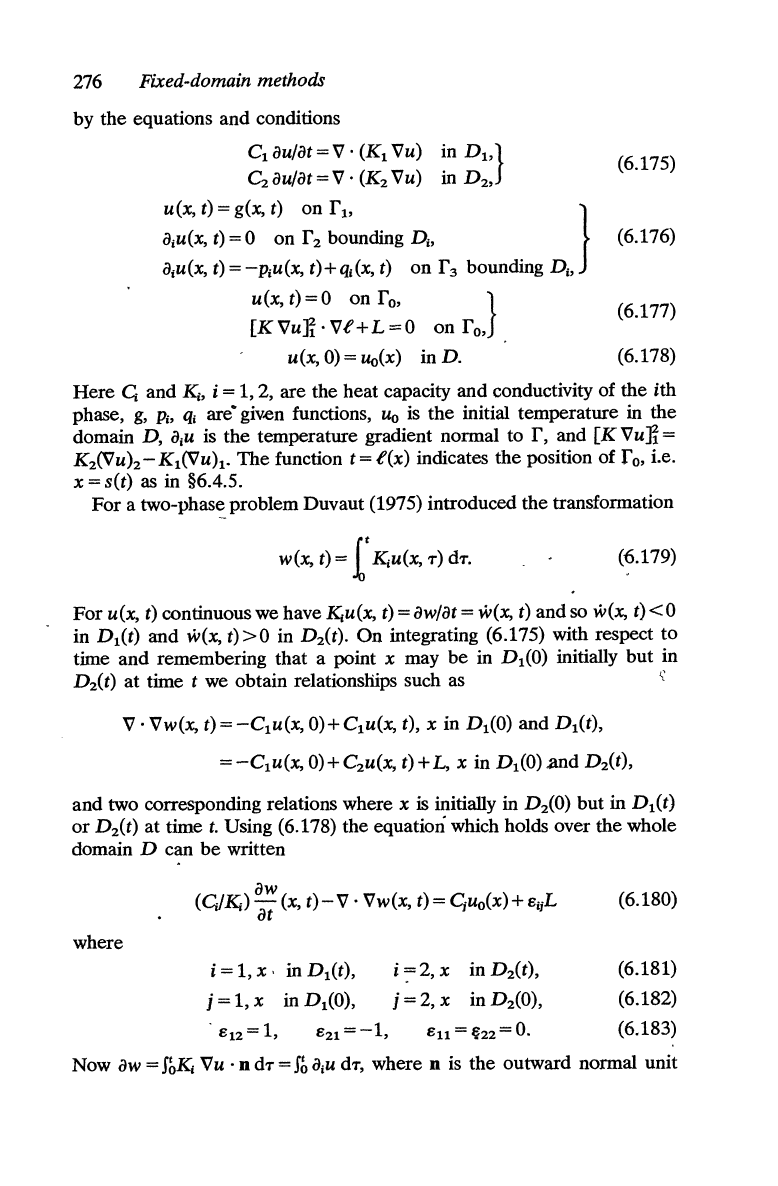
276
Fixed-domain methods
by
the
equations and conditions
C
1
iJU/iJt
= V .
(K
1
Vu) in
Db}
C
2
iJU/iJt
= V .
(K
2
Vu) in D
2
,
u(x,
t) = g(x, t)
on
f1'
}
iJju(x,
t)=O
on
f2
bounding D
..
iJju(x, t) =
-pju(x,
t)+qj(x,
t)
on
f3
bounding D
..
u(x,
t)=O
on
fo, }
[KVu]i'
Vl+L
=0
on
fo,
u(x,
0)
= uo(x) in D.
(6.175)
(6.176)
(6.177)
(6.178)
Here
G and K
..
i = 1, 2, are
the
heat capacity
and
conductivity of
the
ith
phase,
g,
P
..
qj are" given functions,
Uo
is
the
initial temperature in
the
domain
D,
iJiu
is
the
temperature gradient normal
to
f,
and
[KVu]i=
KiVu)2-
K
1
(Vu)1'
The
function
t=
lex)
indicates
the
position
of
r
o
, i.e.
x = set) as in §6.4.5.
For
a two-phase problem Duvaut (1975) introduced
the
transformation
w(x,
t) = r
K;u(x,
T)
dT.
(6.179)
For
u(x,
t) continuous
we
haveK;u(x,
t)=iJw/iJt=
w(x,
t)
and
so w(x,
t)<O
in D
1
(t)
and
w(x,
t»O
in D
2
(t).
On
integrating (6.175) with respect
to
time
and
remembering
that
a point x may
be
in D
1
(0)
initially
but
in
D
2
(t)
at
time t we obtain relationships such as
<;
V . Vw(x, t) =
-C
1
u(x,
0)+
C
1
u(x, t), x in D
1
(0) and D
1
(t),
=-C
1
u(x,
0)+
C
2
u(x,
t)
+ L, x in D
1
(0).and
Dit),
and
two corresponding relations where x is initially in D
2
(0)
but
in D1 (t)
or
D
2
(t)
at
time
t.
Using (6.178)
the
equation which holds over
the
whole
domain D can
be
written
where
iJw
(GlK;)
- (x,
t)-V'
Vw(x,
t)=
Cjuo(x)+ EjjL
iJt
i = 1,
x'
in D
1
(t),
j = 1, x in D
1
(0),
.
E12
= 1,
E21
=-1,
i
,:,,2,
x in
Dit),
j = 2, x in D
2
(0),
Ell
=
~22=0
.
(6.180)
(6.181)
(6.182)
(6.183)
Now
iJw
=
J~K;
Vu . n
dT
=
J~
iJju
dT,
where n is
the
outward normal unit
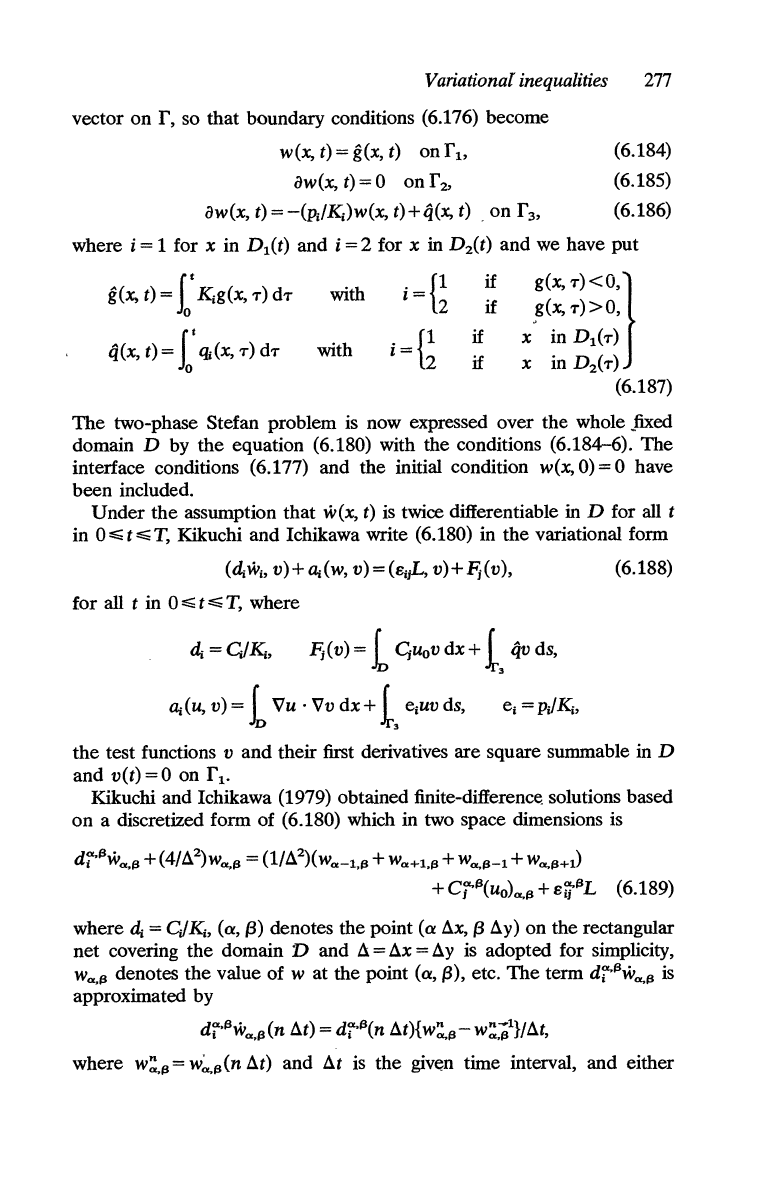
Variational inequalities
277
vector
on
f,
so
that
boundary conditions (6.176) become
w(x, t) = g(x, t)
on
f
1,
aw(x,
t)=O
onf:z,
aw(x, t) =
-(VdKi)w(x,
t)+q(x,
t) .
on
f3'
(6.184)
(6.185)
(6.186)
where
i = 1 for x in
Dl(t)
and i = 2 for x in D
2
(t)
and
we have
put
g(x, t) = r Kig(x,,.) d,.
with
·e
if
g(X,T)<O'}
z=
if
g(x,
,.»0,
2
q(x,
t)=
f q;(x,,.) d,.
with
·e
if
x in Dl('T)
z=
2
if
x in
Di'T)
(6.187)
The
two-phase Stefan problem is now expressed over
the
whole Jixed
domain
D by
the
equation (6.180) with the conditions (6.184-6).
The
interface conditions (6.177) and
the
initial condition w(x,
0)
= 0 have
been included.
Under
the
assumption
that
w(x, t) is twice differentiable in D for all t
in
O~t~T,
Kikuchi and Ichikawa write (6.180) in
the
variational form
(d;wj,
v)+a;(w,
v) =
(Bi~'
v)+
Fj(v),
for all t in
O~t~T,
where
Fj(v) = L
quov
dx +
1.
qv ds,
a;(u, v) = L
VU'
Vv
dx+
1.
ei
uv
ds,
(6.188)
the
test functions v
and
their first derivatives are square summable in D
and
v(t)=O
on
fl'
Kikuchi and Ichikawa (1979) obtained finite-difference solutions based
on
a discretized form of (6.180) which in two space dimensions is
di,(:Iw",,(:I
+
(4l6?)wa,(:I
= (1/a
2
)(w",_1,(:I
+ W",+1,(:I +
Wa,(:I-l
+ Wa,(:I+l)
+
Cj'(:I(uo)a,(:I
+ Bij,(:IL (6.189)
where
d;
= CJKb
(0:,
(3)
denotes
the
point
(0:
ax,
(3
ay)
on
the
rectangular
net
covering
the
domain D and
Il.
=
ax
=
ay
is adopted for simplicity,
wa,(:I denotes
the
value of W at
the
point
(0:,
(3),
etc.
The
term
di'(:Iwa,(:I
is
approximated
by
di,(:Iw"',1l (n
at)
= di,(:I(n at){W:'(:I-
W:;l}/at,
where
w:'(:1
=
w;"(:I(n
at)
and
at
is
the
given time interval, and either
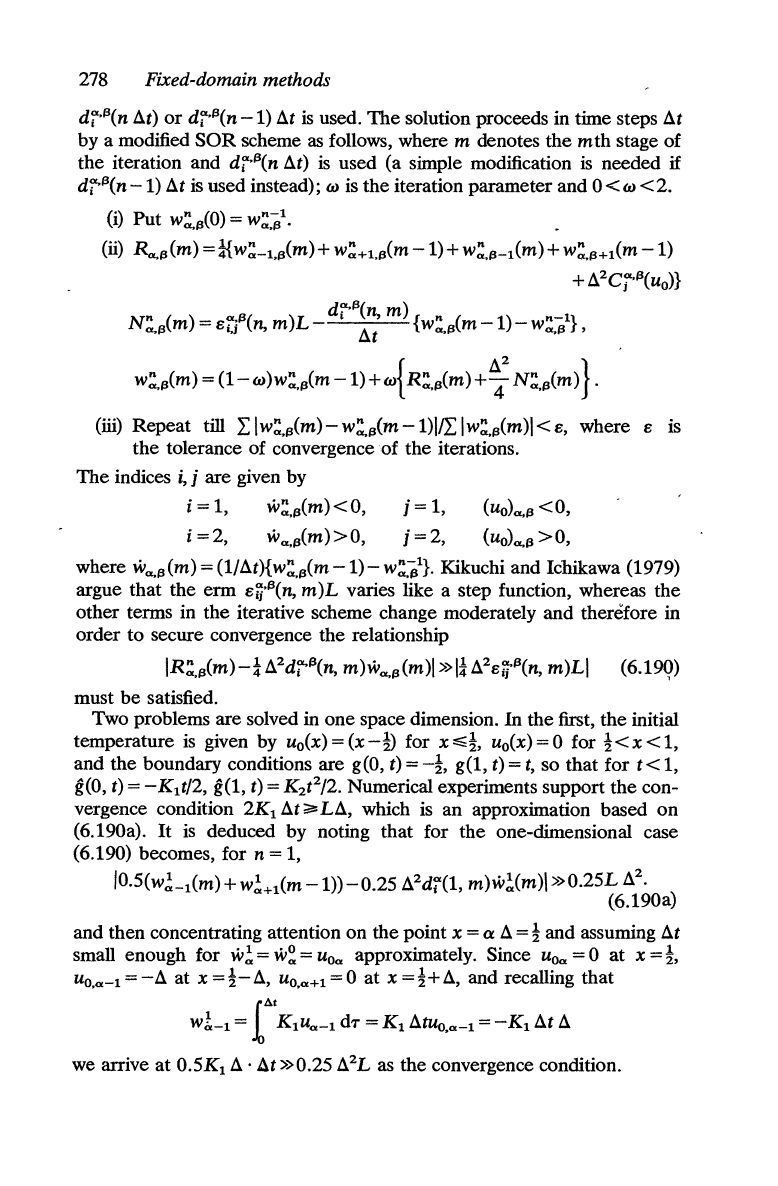
278 Fixed-domain methods
df,13(n
dt)
or
df,13(n
-1)
dt
is
used.
The
solution proceeds in time steps
dt
by a modified
SOR
scheme
as
follows, where m denotes
the
mth
stage of
the
iteration and
df,13(n
dt)
is
used (a simple modification
is
needed
if
di"13(n
-1)
dt
is
used instead); w
is
the
iteration parameter and 0 < w < 2.
(i)
Put
w:,13(O)
=
W:~l.
(ii)
R..,13(m)
= HW:-l,13(m) + W:+l,13(m-1)+
W:,13-1(m)+
w:,13+1(m
-1)
+ d
2
Cj,13(uo)}
N
" (
)-
",13(
)L
di"13(n,
m){
"(
-1)-
n-l}
..
,13
m -
Bi,i
n,
m
dt
W
...
13
m W
..
,13,
w:,13(m)
=
(1-W)W:,13(m-1)+w{R:.
13
(m)+
~2
N:,i
m
)}.
(iii) Repeat
till
I
IW:,13(m)
- w:'im
-1)IJI
IW:,13(m)1
<
B,
where B is
the
tolerance of convergence of
the
iterations.
The
indices
i,
j are given by
i=1,
w:,13(m)<O,
j=1,
(UO)
...
13<O,
i=2,
w",13(m)
>0,
j=2,
(uo)
...
/3>O,
where
w",13(m)=(1/dt){w:,13(m-1)-w:~1}.
Kikuchi and Ichikawa (1979)
argue that the erm
Bij,13(n,
m)L
varies like a step function, whereas the
other terms in
the
iterative scheme change moderately and therefore in
order
to
secure convergence the relationship
IR:,13(m)-i
d
2
di"/3(n,
m)w",13(m)1
»Ii
d
2
Bij13(n,
m)LI
(6.19<,»
must be satisfied.
Two problems are solved in one space dimension.
In
the
first,
the
initial
temperature
is
given by
uo(x)=(x-~
for
x~!,
uo(x)=O
for
~<x<1,
and the boundary conditions are
g(O,
t) =
-!,
g(1, t) =
t,
so that for t < 1,
&(0, t) =
-K
1
t/2,
&(1,
t) = K2t2/2. Numerical experiments support
the
con-
vergence condition
2Kl
dt;:;;:
Ld,
which
is
an approximation based
on
(6.
190a).
It
is
deduced by noting that for the one-dimensional case
(6.190) becomes, for
n = 1,
10.5(w~_1(m)
+
w~+l(m
-1»-0.25
d
2
df(1,
m)w!(m)\»
0.25L d
2
•
(6. 190a)
and then concentrating attention on the point
x = a d
=!
and assuming M
small enough for
w!
=
w~
=
Uo
..
approximately. Since
Uo..
= 0
at
x
=!,
UO,
..
-l
=
-d
at x
=!-d,
uo,
..
+1
= 0
at
x
=!+d,
and recalling that
L
~t
wl-l
= K1u
..
-l
d'T
=
Kl
dtUO,
..
-l
=
-K
1
dt
d
we arrive
at
0.5Kl
d'
At»0.25
d
2
L
as
the convergence condition.
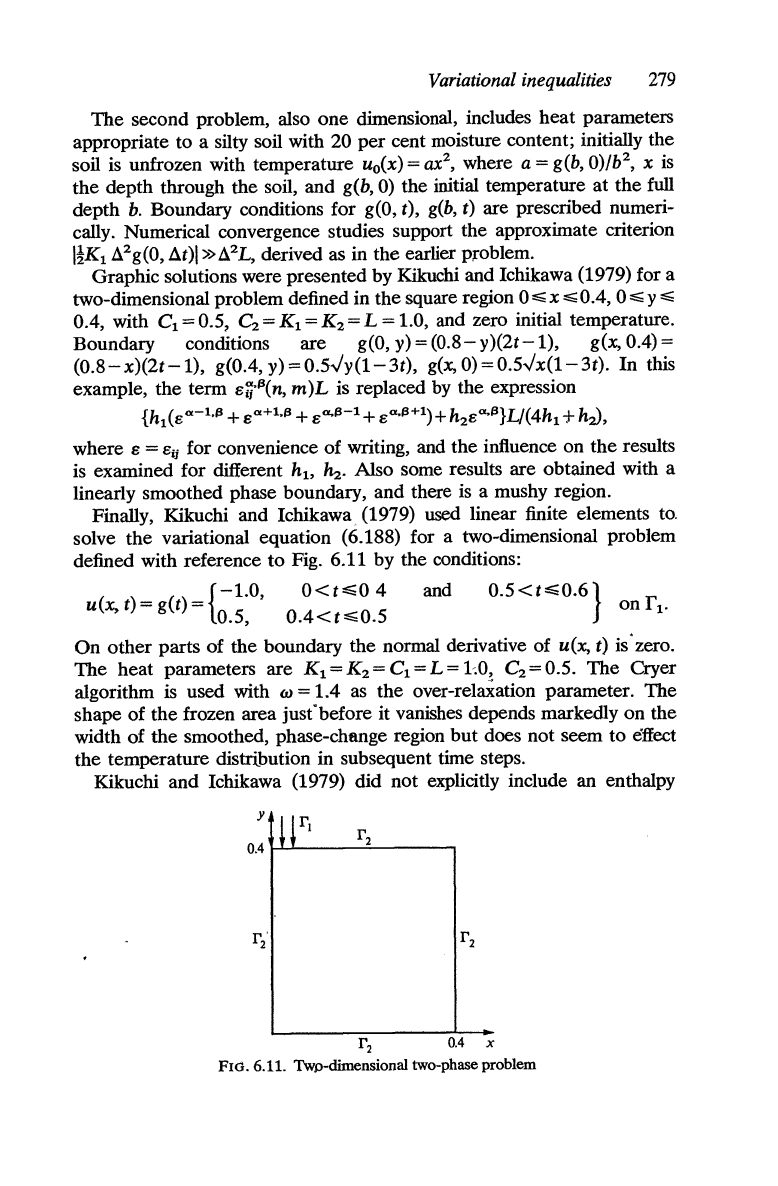
Variational inequalities
279
The
second problem, also
one
dimensional, includes
heat
parameters
appropriate
to
a silty soil with
20
per
cent
moisture content; initially
the
soil is unfrozen with temperature uo(x) = ax
2
, where a = g(b,
0)/b
2
,
x is
the
depth
through
the
soil,
and
g(b,O)
the
initial temperature
at
the
full
depth
b.
Boundary conditions
for
g(O,
t), g(b, t) are prescribed numeri-
cally. Numerical convergence studies support the approximate criterion
\!K1 a
2
g(0,
.at)\»
a
2
L, derived as in
the
earlier Problem.
Graphic
solutions were presented by Kikuchi and Ichikawa (1979) for a
two-dimensional problem defined in
the
square region
O~x~O.4,
O~y~
0.4, with C
1
= 0.5, C
2
=
K1
= K2 = L = 1.0, and zero initial temperature.
Boundary conditions
are
g(0,y)=(0.8-y)(2t-1),
g(x,O.4)=
(0.8 - x)(2t
-1),
g(O.4, y) =
O.s.Jy(l-
3t), g(x, 0) =
0.5.Jx(1-
3t).
In
this
example,
the
term
8ij,13(n,
m)L
is replaced by
the
expression
{h1
(e",-l,13
+ 8",+1,13 + 8",,13-
1
+ 8",,13+
1
) + h
28
a.13}L/(4h
1
+ hz),
where
8 =
8ij
for convenience of writing, and
the
influence
on
the
results
is examined for different
hi>
h
2
•
Also
some results
are
obtained with a
linearly smoothed phase boundary,
and
there is a mushy region.
Finally, Kikuchi and Ichikawa
(1979) used linear finite elements
to.
solve
the
variational equation (6.188) for a two-dimensional problem
defined with reference
to
Fig. 6.11 by
the
conditions:
(
)
_
()_{-1.0,
O<t~O
4 and
0.5<t~0.6}
u x, t - g t -
05
04
",;:::05
on
fl'
. , . <t...., .
On
other
parts
of
the
boundary
the
normal derivative of u(x, t) is' zero.
The
heat
parameters
are
K1
=K2=
C
1
=L=
1.0, C
2
=0.5.
The
Cryer
algorithm is used with
w =
1.4
as
the
over-relaXation parameter.
The
shape
of
the
frozen area just
'before
it vanishes depends markedly
on
the
width
of
the
smoothed, phase-change region
but
does
not
seem
to
effect
the
temperature
distribution in subsequent time steps.
Kikuchi
and
Ichikawa (1979) did
not
explicitly include
an
enthalpy
r
2
0.4
x
Fw.
6.11. Twp-dimensional two-phase problem
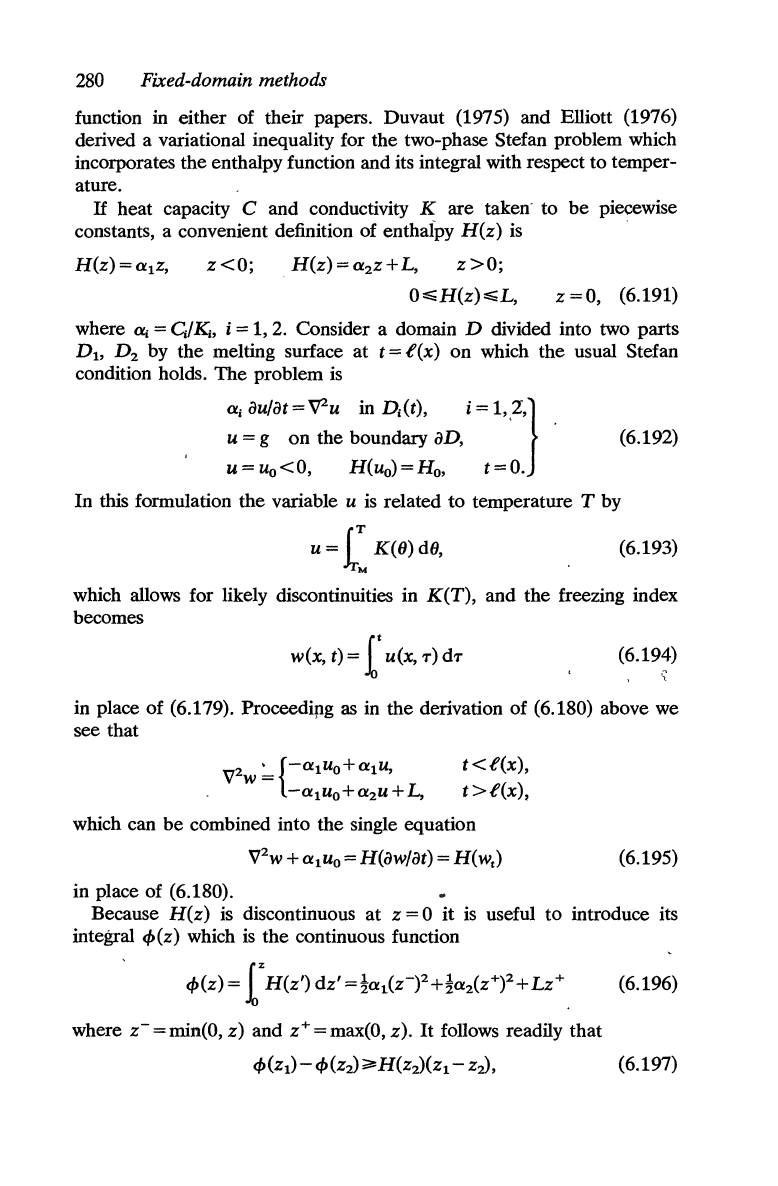
280
Fixed-domain methods
function in
either
of their papers.
Duvaut
(1975)
and
Elliott (1976)
derived a variational inequality for
the
two-phase Stefan problem which
incorporates
the
enthalpy function and its integral with respect
to
temper-
ature.
If
heat
capacity C
and
conductivity K
are
taken
to
be
piecewise
constants, a convenient definition of enthalpy
H(z)
is
H(Z)=O'.lZ,
z<O;
H(z)
=
0'.2Z
+L,
z>O;
O~H(z)~L,
z = 0, (6.191)
where
0'.;
=
G/Kb
i = 1, 2. Consider a domain D divided into two
parts
Dh
D2 by
the
melting surface
at
t
==
lex)
on
which
the
usual Stefan
condition holds.
The
problem
is
O'.i
au/at
==
VZu in Di(t), i = 1,
,Z,}
.
u = g
on
the
boundary aD,
u=uo<O,
H(uo) = H
o
,
t=O.
(6.192)
In
this formulation
the
variable u is related
to
temperature T by
u
=.C
K(6)
d6,
(6.193)
which allows for likely discontinuities in
K(T),
and
the
freezing index
becomes
w(x, t) = f u(x,
'T)
d'T
(6.194)
;;
in place
of
(6.179). Proceedipg as in
the
derivation of (6.180) above
we
see
that
t<l(x),
t>l(x),
which can
be
combined into
the
single equation
V
2
w +
0'.1
Uo
= H(aw/at) =
H(
w,)
in place of (6.180).
(6.195)
Because
H(z)
is discontinuous
at
z = 0
it
is useful
to
introduce its
integral
4>(z)
which
is
the
continuous function
4>(z)
=
rH(Z')dZ'=!0'.1(Z-?+~0'.2(z+)2+LZ+
(6.196)
where
z-=min(O,z)
and
z+=max(O,z).
It
follows readily
that
4>(Zl)-4>(Z2);;;,:H(Z2)(Z1-
z~,
(6.197)
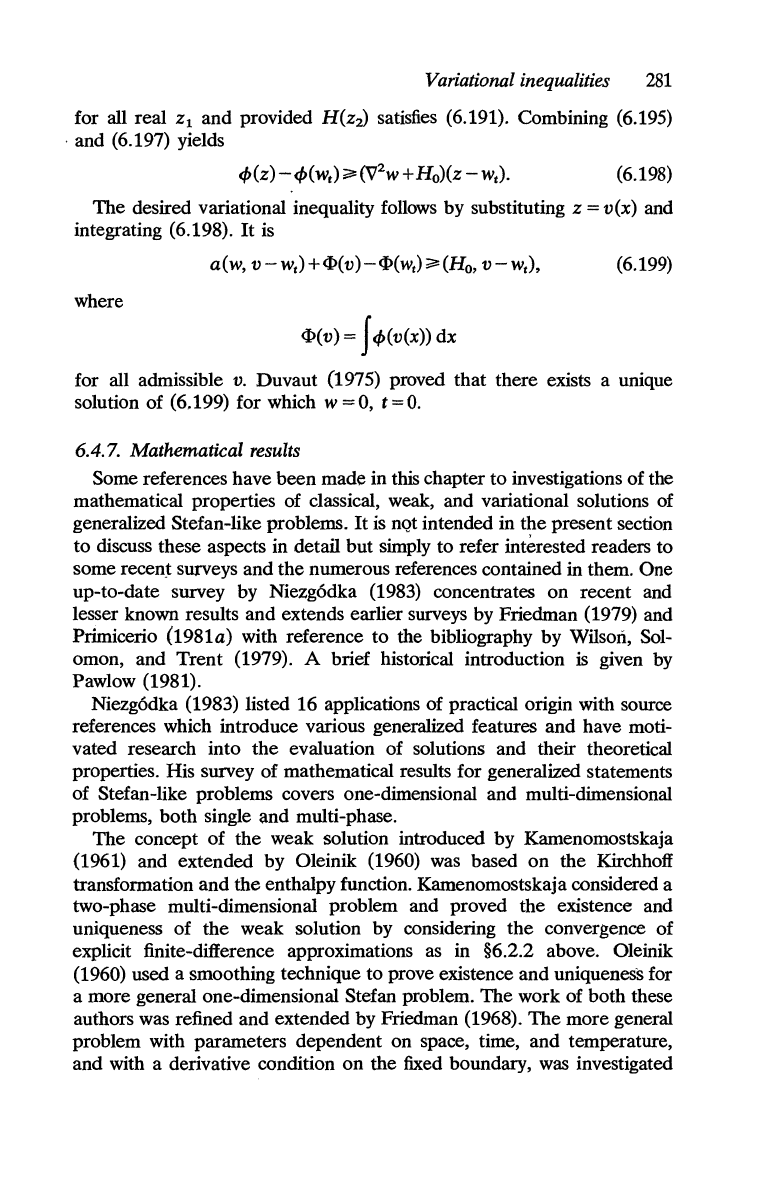
Variational inequalities
281
for all real
Zl
and provided H(Z2) satisfies (6.191). Combining (6.195)
. and (6.197) yields
(6.198)
The
desired variational inequality follows by substituting Z =
v(x)
and
integrating (6.198).
It
is
(6.199)
where
cI>(v)
= J
4>
(v
(x»
dx
for all admissible
v.
Duvaut (1975) proved that there exists a unique
solution of (6.199) for which
w
:0,
t=O.
6.4.7. Mathematical
results
Some references have been made in this chapter
to
investigations of the
mathematical properties of classical, weak, and variational solutions of
generalized Stefan-like problems.
It
is
nQt
intended in the present section
to
discuss these aspects in detail but simply
to
refer interested readers to
some recenj surveys and
the
numerous references contained in them. One
up-to-date survey by Niezg6dka (1983) concentrates on recent and
lesser known results and extends earlier surveys by Friedman (1979) and
Primicerio
(1981a) with reference
to
the bibliography by Wilson, Sol-
omon, and
Trent
(1979). A brief historical introduction is given by
Pawlow (1981).
Niezg6dka (1983) listed 16 applications of practical origin with source
references which introduce various generalized features and have moti-
vated research into
the
evaluation of solutions and their theoretical
properties. His survey of mathematical results for generalized statements
of Stefan-like problems covers one-dimensional and multi-dimensional
problems, both single and multi-phase.
The
concept of the weak solution introduced by Kamenomostskaja
(1961) and extended by Oleinik (1960) was based
on
the Kirchhoff
transformation
and
the
enthalpy function. Kamenomostskaja considered a
two-phase multi-dimensional problem and proved the existence and
uniqueness of the weak solution by considering
the
convergence of
explicit finite-difference approximations
as
in §6.2.2 above. Oleinik
(1960) used a smoothing technique
to
prove existence and uniqueness for
a more general one-dimensional Stefan problem.
The
work of both these
authors was refined and extended by Friedman (1968).
The
more general
problem with parameters dependent on space, time, and temperature,
and with a derivative condition on the fixed boundary, was investigated
